 and Bookivore is in a fair way to losing her mind.
and Bookivore is in a fair way to losing her mind. 
I Eat Books for Lunch
 and Bookivore is in a fair way to losing her mind.
and Bookivore is in a fair way to losing her mind. 
 Marianne Richmond's Beautiful Brown Eyes is a sweet little book about all the things we see when we look at our children's eyes. In a realistic dialogue between a mother and child, it reaffirms the connection parents have with their little ones, the way we learn to "read" them, their moods and expressions, the way we stalk them with our cameras trying to capture those little faces.
Marianne Richmond's Beautiful Brown Eyes is a sweet little book about all the things we see when we look at our children's eyes. In a realistic dialogue between a mother and child, it reaffirms the connection parents have with their little ones, the way we learn to "read" them, their moods and expressions, the way we stalk them with our cameras trying to capture those little faces. What a cute book. How to Potty Train Your Monster by Kelly DiPucchio takes the potty training concept book and turns it on its head. Instead of a 2-3 year old, the monster must be 200-300 years old. Instead of a smaller potty chair, monsters need huge potty chairs. And of course, monsters don't read books on the potty, they eat them. Naturally, Bookivore appoves of this wholeheartedly.
What a cute book. How to Potty Train Your Monster by Kelly DiPucchio takes the potty training concept book and turns it on its head. Instead of a 2-3 year old, the monster must be 200-300 years old. Instead of a smaller potty chair, monsters need huge potty chairs. And of course, monsters don't read books on the potty, they eat them. Naturally, Bookivore appoves of this wholeheartedly.
The artwork by Mike Moon is cartoony and fun, and it does a nice job of treating a sometimes-serious subject in a lighthearted way. If the battle over toilet training has gotten tense at your house (like it sometimes has at mine) this is a good tool for defusing the stress, for you if not for your child.
It sure helped me to remember to lighten up a little and realize I'm going to look back on the potty training years with laughter. Might as well start now.

What I like about The One Year Everyday Devotions by Stephen Arterburn and Jesse Florea was that it almost always uses a Bible story for the lesson. Many, many kid's devotionals use a modern story to illustrate the lesson, then they tie that story to a biblical principle. I think this is okay, but I'd rather my kids get really familiar with the Bible itself and what they can learn from it, especially for my 8 year old. Another thing I liked was that this devo uses the New Living Translation for the Bible passages, which is very accessible and understandable for kids. The lessons are a good length and have pithy points that seem more likely to stick with the reader. The writing style is nice -- casual and conversational.
For my sports-crazed 6 year old:

I struggled with a devotional for my 6 year old. I had a hunch he'd be offended by anything that seemed too babyish, but at the same time something like the Arterburn devo is just beyond him. Truthfully, the reading level of Heads Up: Sports Devotions for All-Star Kids by Dave Branon is also beyond him, but I think the subject matter will appeal to him so I'm going to risk it. This devotion (probably more for 9 year olds and up) uses examples of real athletes from a wide range of sports who are living out their Christian faith. There were some nice lessons dealing with things like sharing your faith, and how your behavior can undermine your witness. In addition to the lessons, there are random sports factoids which I think my son will find interesting. We'll be reading this one to him for a year or so, but I think it's one he can grow into.
For my 3 year old:

God's Amazing Creatures and Me by Helen and Paul Haidle says it's for 6-10 year olds, but when I flipped through it at the bookstore, I thought it might appeal to my 3 year old. Some of the lessons are going to go straight over her head, but it has pictures on every page and uses animal characteristics and behavior to illustrate biblical principles, particularly the idea that God has a plan and design for each of us. In one devotion, it describes how a male Emperor penguin incubates its egg on its feet for 60 long days in the freezing cold. Nothing much happens with that egg until the 60th day -- then, there's the baby! Enter the story of Elijah and his perseverance -- what if Elijah had given up because nothing much seemed to be happening? It'll be a stretch for a 3 year old, but I think it's a nice one to grow into.
I want to hasten to say that I went through probably 15 different devotional books looking for ones that would be a good fit for my kids -- for their reading levels, comprehension abilities, and interests. Unless you know the book well, it's probably NOT A GOOD IDEA TO BUY ONLINE. This is one purchase where you need to go to a bookstore (and not Barnes and Noble -- a Christian bookstore so you get a really good selection of devotionals) and spend some time looking through devotionals until you find one that you think your child(ren) will like. And by "spend some time," I mean plan on about 30 minutes or so. If you're not giving it as a surprise, you could take your child(ren) along and let them look, too. I made a list of the most promising ones, then came home and looked them up on one of the Big Two websites to check the target ages and read reviews from others who had purchased them. Then I went back and purchased them.
Why so much care? I want their devotionals to be appealing and inviting, something they look forward to reading with us or by themselves. If we can instill in them this practice now of reading their Bibles and thinking about what they read, it will be something they come back to again and again into adulthood.
Just keepin' our eyes on the prize.
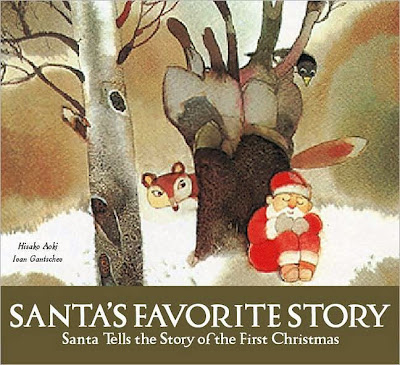
 RRoom for a Little One by Martin Waddell may end up in my 3 year old's stocking this year. It's got pretty pictures and a sweet story. Animals are coming one by one -- tired, old, lost -- and all are welcomed into the stable. At last, Mary and Joseph arrive and are welcomed, too. When baby Jesus makes his appearance, well, of course there's room for him as well. The paintings positively glow and it comes in a nice boardbook format.
RRoom for a Little One by Martin Waddell may end up in my 3 year old's stocking this year. It's got pretty pictures and a sweet story. Animals are coming one by one -- tired, old, lost -- and all are welcomed into the stable. At last, Mary and Joseph arrive and are welcomed, too. When baby Jesus makes his appearance, well, of course there's room for him as well. The paintings positively glow and it comes in a nice boardbook format. The next two are so similar, I think you could probably throw a dart and be equally happy with either. Voices of Christmas by Nikki Grimes and The Twelve Prayers of Christmas by Candi Chand. Their formats are almost identical: a retelling of the Christmas story through a variety of perpectives. In Twelve Prauers the perspectives are rendered as prayers, while Voices tells the story in first-person narrative poems.
The next two are so similar, I think you could probably throw a dart and be equally happy with either. Voices of Christmas by Nikki Grimes and The Twelve Prayers of Christmas by Candi Chand. Their formats are almost identical: a retelling of the Christmas story through a variety of perpectives. In Twelve Prauers the perspectives are rendered as prayers, while Voices tells the story in first-person narrative poems.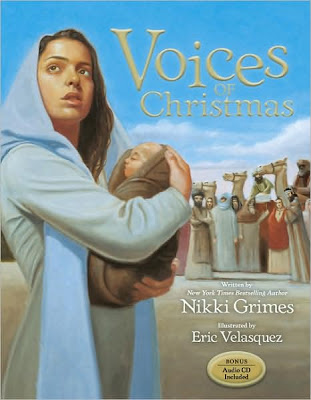
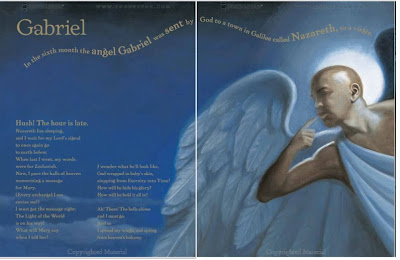 Both books have stunning artwork and I loved the ethnic flavor of both -- Gabriel is black, Mary looks hispanic or middle eastern, baby Jesus has dark hair. It makes a nice change. My sense of Voices is that it's more Poetry (with a capital p) and some of the lines seem better suited for older kids. In Joseph's poem, he wonders "How can I marry a girl who is having someone else's baby?" Most of the Voices poems are longer than those in Twelve Prayers, again making them maybe a little better for older kids. Twelve Prayers poems are shorter, rhymed texts, beginning with Mary and ending with Jesus. Both of these are gorgeous books with lush, detailed paintings amply complimenting the writing.
Both books have stunning artwork and I loved the ethnic flavor of both -- Gabriel is black, Mary looks hispanic or middle eastern, baby Jesus has dark hair. It makes a nice change. My sense of Voices is that it's more Poetry (with a capital p) and some of the lines seem better suited for older kids. In Joseph's poem, he wonders "How can I marry a girl who is having someone else's baby?" Most of the Voices poems are longer than those in Twelve Prayers, again making them maybe a little better for older kids. Twelve Prayers poems are shorter, rhymed texts, beginning with Mary and ending with Jesus. Both of these are gorgeous books with lush, detailed paintings amply complimenting the writing.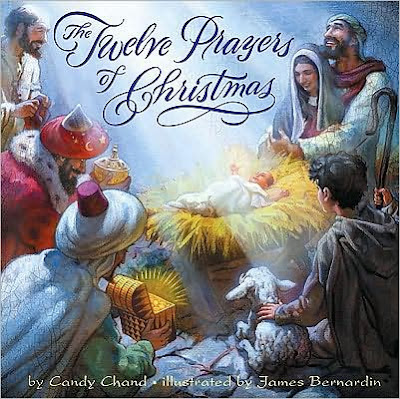
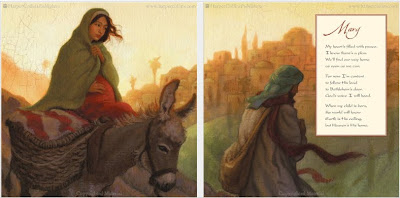
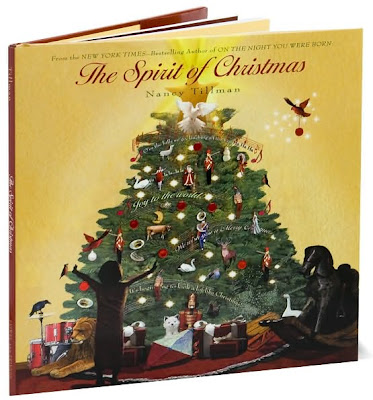
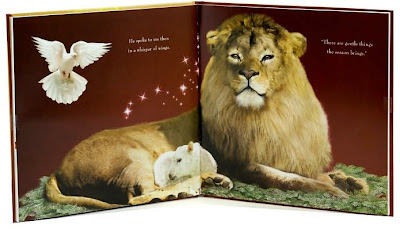 I like to have a collection of books like this to bring out at Christmas and leave scattered on end and coffee tables. Even my oldest, who is "too old for picture books, Mom!" will pick them up and thumb through them. It's nice to have some new options for the season.
I like to have a collection of books like this to bring out at Christmas and leave scattered on end and coffee tables. Even my oldest, who is "too old for picture books, Mom!" will pick them up and thumb through them. It's nice to have some new options for the season. Sometimes, boys are a little harder to motivate in the reading department than girls. This isn't always true, but in my years of teaching I would say that in general, boys had a harder time finding stuff that interested them than girls, who tended to be more omnivorous in their reading preferences. For grade school boys who are interested in sports, Matt Christopher can be a real Godsend.
Sometimes, boys are a little harder to motivate in the reading department than girls. This isn't always true, but in my years of teaching I would say that in general, boys had a harder time finding stuff that interested them than girls, who tended to be more omnivorous in their reading preferences. For grade school boys who are interested in sports, Matt Christopher can be a real Godsend.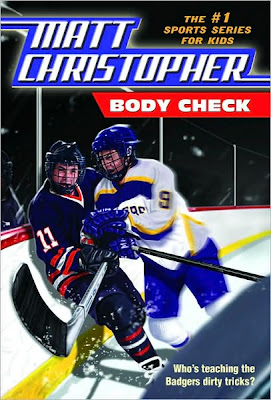 I only discovered him because my 6 year old son emptied his piggy bank during the Scholastic Book Fair at his school and came home with three books about football. Double Threat by Matt Christopher was one of those books. It's a book meant for independent readers; it has no pictures and runs 128 pages. However, it worked well as a read aloud book, too, and since my son is currently obsessed with football, he was willing to sit and listen to the whole book, which took us about 4-5 days to read.
I only discovered him because my 6 year old son emptied his piggy bank during the Scholastic Book Fair at his school and came home with three books about football. Double Threat by Matt Christopher was one of those books. It's a book meant for independent readers; it has no pictures and runs 128 pages. However, it worked well as a read aloud book, too, and since my son is currently obsessed with football, he was willing to sit and listen to the whole book, which took us about 4-5 days to read. What the book does is take a story and then weaves it around some sport -- in this case football -- incorporating lots of play-by-play action. My son was riveted. He even stopped playing with his legos to listen. The next morning, he brought it to the breakfast table and wanted me to read it while he ate breakfast. Talk about motivation.
What the book does is take a story and then weaves it around some sport -- in this case football -- incorporating lots of play-by-play action. My son was riveted. He even stopped playing with his legos to listen. The next morning, he brought it to the breakfast table and wanted me to read it while he ate breakfast. Talk about motivation.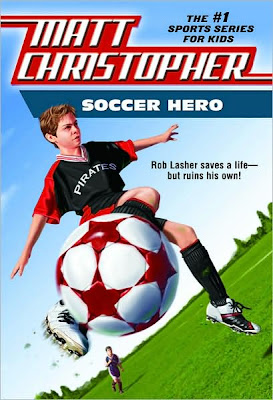
 Next spring, when he's playing baseball again, there are Matt Christopher baseball books for him to read. And in the fall, when we go back to soccer, there are soccer books as well. In fact, if you have a child that plays a sport, any sport, chances are good there's a Matt Christopher book about it. In addition to the mainstream biggies (football, basketball, soccer and baseball), hockey, snowboarding, skateboarding, and even such esoteric things as lacrosse have made it into Christopher's books.
Next spring, when he's playing baseball again, there are Matt Christopher baseball books for him to read. And in the fall, when we go back to soccer, there are soccer books as well. In fact, if you have a child that plays a sport, any sport, chances are good there's a Matt Christopher book about it. In addition to the mainstream biggies (football, basketball, soccer and baseball), hockey, snowboarding, skateboarding, and even such esoteric things as lacrosse have made it into Christopher's books.







 In my quest to find age-appropriate books for my 8 year old, I have read my share of disappointing books. Allie Finkle, for example, didn't really float my boat. Utterly Me, Clarice Bean, on the other hand, hit the mark just right.
In my quest to find age-appropriate books for my 8 year old, I have read my share of disappointing books. Allie Finkle, for example, didn't really float my boat. Utterly Me, Clarice Bean, on the other hand, hit the mark just right.
 Just like a Ruby Redfort novel, Clarice find herself in the middle of a mystery -- Betty has disappeared! -- and she finds herself reassigned to a new partner, the most awful boy in class. As if that weren't bad enough, the book project trophy is stolen and Clarice's new partner is blamed. Clarice has to set things right before the night of the project presentations.
Just like a Ruby Redfort novel, Clarice find herself in the middle of a mystery -- Betty has disappeared! -- and she finds herself reassigned to a new partner, the most awful boy in class. As if that weren't bad enough, the book project trophy is stolen and Clarice's new partner is blamed. Clarice has to set things right before the night of the project presentations.

You'll notice that this is a Newberry Honor book. Usually that means it's good.
Anyway, she was having a snit about being forced to read it, so I told her I would take a look at it. My thinking was that if I could read it first, I could help her get engaged with it and smooth the way a bit. Hey, I was an English teacher; I did not in any way intend to let her off the hook.
So I read it. I was only about 4 pages in when I began to be uncomfortable. It's about a boy named Jake who has been kicked out of every school he's ever been in. Rumor has it that he may have actually burned one of his schools to the ground. His parents are both in jail -- for growing marijuana in their basement and "offering" it to an undercover police officer. Though the book doesn't explicitly say so, I think this is euphemistic language for "selling."
Perhaps you can see where I was beginning to have trouble with this book.
Kicked out of yet another school, Jake is sent to the Applewhites, an artistic family with an "academy" -- basically a homeschool set-up that will allow them to pursue their artistic endeavors free of the stultifying influence of the public schools. Jake has a colorful vocabulary, as you might expect from a juvenile delinquent. His swearing is not explicitly recorded, but the Applewhites have a parrot with a potty mouth, so comparisons are drawn between the two.
I turned the book over and looked at the back to see what, if any, commentary it had. And I saw this:
Can you see it? Here, I'll make it bigger:

My daughter is 8. Obviously, we've got an issue here. The marijuana selling and the swearing aside, this book dealt with themes that are just too mature for an 8 year old. The two main characters are 12 and 13, the first clue that this book was probably going to be thematically beyond her. Generally speaking, the age of the protagonists is the approximate age of the target audience.
This is not, let me hurry to say, a bad book. It would be fine if my daughter were in 5th or 6th grade (the age when, incidentally, my 12 year old niece read it). But there's a certain innocence that my daughter still has and that I want to protect as long as I can. So, I emailed the teacher. In my email, I specifically mentioned the marijuana growing, because I really felt that that by itself should preclude the book even being offered to 3rd graders. I assumed the teacher had probably not read the book and was operating out of ignorance.
As a parent, I have absolute authority over what my child reads. The school district cannot force her to read something that I find objectionable. I cannot dictate what anyone else reads but I can dictate what my child reads.
The teacher was willing to have the whole group change books, something I didn't expect. I was prepared to have my daughter reading something independent of the group, but this was a nice surprise. Problem solved. Sort of.
Here's the next book they wanted to read:

Now, I know a lot of people have read and loved Neil Gaiman's stuff, and this book is "recommended" for 9-12 year olds, so it's close to my daughter's age. But -- and this is a big but-- this book has strong elements of horror in it. And since my daughter has suffered from nightmares most of her life, you can see where I might have trouble with this one, too. No argument from her at all -- she wanted to read it -- the problem was all with me. I told her I'd have to read it first before I could sign off on it.
At that point, I contacted the teacher and asked for a list of the books they had to choose from. Forewarned is forearmed, my mom always says.
The purpose of guided reading is for kids to read in a small group with others at their reading level. They read aloud, which enables the teacher to see what mistakes they're making as they read, either with decoding or comprehension, and support them so they can improve.
Now, I want to tread carefully here so my point is not lost. If, like me, you have a strong reader, you may run into the problem of a child who can read many grade levels above their chronological age. The teacher may have trouble finding books which stretch your child's vocabulary and reading ability because to get them to the right level, they must choose books that are geared for older children. Older=Harder, right? But sometimes Older=Inappropriate when the audience is much younger than intended. Just because they can read books for older kids doesn't mean they should.
I suspect I'm in a minority here, because I know many children my kids' ages who routinely see PG, PG-13 and even R-rated movies. Obviously their parents aren't going to object to either of the books I've featured here. But there is a certain innocence in children that should be protected, and that's my job. I don't expect the teacher to have read all the Guided Reading books -- that would be asking a lot of one person. But I can, and will, vet every book my child is asked to read. I'll put it through my mom-filter and decide whether it's okay. I wish I didn't have to do this in 3rd grade, but I do.
And you do, too. Don't assume that everything your child is given to read is okay. Much of it probably is, but do yourself, and your child, the favor of reading it yourself and seeing how it stands up to your mom-filter. At the very least, get on Amazon.com or BarnesandNoble.com and read what others had to say about it. Check their listings or the publisher's website to see what the age of the target audience is. Ask the teacher for a list of the books they're expected or allowed to read. Don't assume the teacher is trying to corrupt your child. Politely request another book if something sets off your alarms. This bears repeating: be polite.
There's a lot of stuff out there that 8 year olds don't need to be thinking about. Once their innocence is gone, it's gone.
Know what your kids are being given to read.

It gets better. Just look.

Impressive, no? I can tell you right now, that my 10 year old nephew and my 6 year old son were drooling over this book when they saw it at the bookstore.
Drooling.

Books like this are awesome, because the little monkeys almost don't realize they're reading. They'll pore over this, absorbing all the information about every last brick.
And there are a lot of bricks featured here.

Now the only question is do I buy it for them, or do we wait to see if Santa comes through?

I was already familiar with Isadora's retelling of a number of fairy tales (Princess and the Pea, The Fisherman's Wife, The Twelve Dancing Princesses, Hansel and Gretel), but every time I open one of her books, the energy of the paintings just blows me away.
Isadora's artwork is reminiscent of Eric Carle's, but she gives hers a more global flavor. This version has distinctly African characters and is in saturated color that leaps off the page. This is no Currier & Ives version of Moore's poem. It's gorgeous and thoroughly modern. Love it.
This one is vintage Englebreit, with cute-as-pie elves and mice and all manner of detail in every two-page spread. The pictures are playful, engaging and nostalgic. My littlest one requests this book year round. It's candy for the eyes.

Even more nostalgic, but in a completely different way, is Gennady Spirin's version.
This one is closer to what I'd call the "classic" interpretation; everything looks quaintly European and softly lit. Spirin's paintings always make me think of the renaissance masters, the way they play with light. He has many books which cover a range of Christmas songs and themes and they are all lovely. This one is of a caliber to leave out on your coffee table.
Last is Robert Sabuda's take on the Night Before Christmas; a high-contrast pop-up book, also suitable for the coffee table, if you have older kids. This one is NOT recommended if you have babies or toddlers, since it likely wouldn't survive the season.

It's strongly graphic and very cool, modern and yet retaining an element of the classic about it; I'm always reminded of traditional scherenschnitte pictures, though they're not really like that. Every time I look at this one, I think "How did he figure out how to do that?"
I love all of these and yet none of them is precisely like the edition I remember so fondly from my childhood. Sadly, that book is long gone and despite many long searches through the scads of other versions, I've never been able to locate that exact one. Still, I'm glad there are so many of this classic to choose from so my children, though with different "visions of sugarplums" dancing in their heads, will have the same fond memories.


